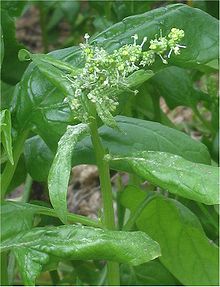
Back Spinasie Afrikaans ቆስጣ Amharic Spinacia oleracea AN سبانخ Arabic سبانخ ARZ পালেং শাক Assamese Spinacia oleracea AST Dirrik ispanağı Azerbaijani ایسپاناق AZB Echter Spinat BAR
| Spinach | |
|---|---|

| |

| |
| Scientific classification | |
| Kingdom: | Plantae |
| Clade: | Tracheophytes |
| Clade: | Angiosperms |
| Clade: | Eudicots |
| Order: | Caryophyllales |
| Family: | Amaranthaceae |
| Genus: | Spinacia |
| Species: | S. oleracea
|
| Binomial name | |
| Spinacia oleracea | |
Spinach (Spinacia oleracea) is a leafy green flowering plant native to central and Western Asia. It is of the order Caryophyllales, family Amaranthaceae, subfamily Chenopodioideae. Its leaves are a common edible vegetable consumed either fresh, or after storage using preservation techniques by canning, freezing, or dehydration. It may be eaten cooked or raw, and the taste differs considerably; the high oxalate content may be reduced by steaming.
It is an annual plant (rarely biennial), growing as tall as 30 cm (1 ft). Spinach may overwinter in temperate regions. The leaves are alternate, simple, ovate to triangular, and very variable in size: 2–30 cm (1–12 in) long and 1–15 cm (0.4–5.9 in) broad, with larger leaves at the base of the plant and small leaves higher on the flowering stem. The flowers are inconspicuous, yellow-green, 3–4 mm (0.1–0.2 in) in diameter, and mature into a small, hard, dry, lumpy fruit cluster 5–10 mm (0.2–0.4 in) across containing several seeds.
In 2022, world production of spinach was 33 million tonnes, with China alone accounting for 93% of the total.[1]